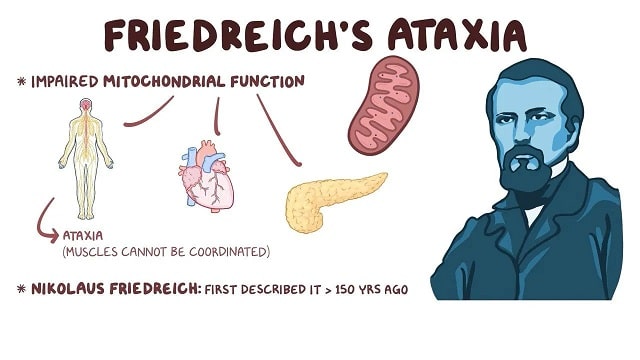Friedreich’s ataxia is a muscle coordination disorder (ataxia) caused by degenerative damage to the nervous system. This disease occurs due to a mutation in a gene on chromosome 9 and is an autosomal recessive inherited disease. This disorder was first described by Nikolaus Friedreich from Germany.
Friedreich’s Ataxia Symptoms
Complaints in people with Friedrich’s Ataxia usually begin before or during puberty. However, in some people, complaints can arise at a younger or older age. Initial complaints are usually difficulty walking and become increasingly severe. Furthermore, symptoms will spread to the hands and the entire body. Muscles will weaken, tendon reflexes will decrease until they disappear, and there will be a loss of sensation throughout the body.
Usually, sufferers will experience a curvature of the spine (scoliosis). When the muscles in the mouth and face are affected, there will be speech disorders and involuntary eye movements (nystagmus), and chest pain and difficulty breathing can occur.
In addition to the symptoms that arise, usually in Friedreich’s Ataxia there are also heart disorders, such as heart enlargement (cardiomyopathy), myocardial fibrosis, and heart failure. In some cases, there can be impaired glucose tolerance, diabetes mellitus, and hearing or vision loss. The speed or slowness of the progression of symptoms in Friedreich’s Ataxia varies, but usually, heart disorders and disorders of the respiratory muscles cause fatality in this disease.
Causes of Friedreich’s Ataxia
Friedreich’s Ataxia is caused by a mutation in the FXN gene on chromosome 9. This gene is responsible for regulating the production of a protein called frataxin. This protein regulates the amount of iron in the mitochondria, which is the source of cellular respiration. If there is too much iron in the mitochondria, frataxin will be released. Likewise, frataxin will be stored in a special place in the mitochondria.
Mutations in the FXN gene cause a reduction in the frataxin protein and an accumulation of iron in the mitochondria which causes oxidative stress and results in damage to muscles, the nervous system, the heart, and other tissues.
Friedreich’s Ataxia is an autosomal recessive inherited disease. This means that both parents have one hidden mutation in their gene, but do not have symptoms (carriers). If both parents work and are going to have a child, there is a 25 percent risk of having symptoms of Friedreich’s Ataxia. This percentage applies to every pregnancy.
Risk Factors for Friedreich’s Ataxia
Several things are associated as risk factors for Friedreich’s Ataxia, such as:
- Having both parents as carriers.
- Caucasoid race.
Friedreich’s Ataxia Diagnosis
As a disease whose symptoms appear slowly and can be similar to other diseases, establishing a diagnosis of Friedreich’s Ataxia usually requires several consultations. The doctor will examine family history, symptoms, and physical examination results. Furthermore, several supporting examinations will be carried out to confirm, such as:
- Blood test.
- Imaging scans, such as an MRI or CT scan.
- A nerve conduction study that uses electrical impulses to examine nerve activity.
- Cardiac examinations, for example electrocardiography and echocardiography.
- Muscle examination, for example electromyography.
- Genetic testing.
Friedreich’s Ataxia Treatment
Until now there is no therapy that can cure Friedreich’s Ataxia, so treatment is given to relieve symptoms and optimize the quality of life of sufferers. Therapy is usually carried out by a special team consisting of several specialists and regular check-ups are needed to always be able to carry out activities as optimally as possible.
Prevention of Friedreich’s Ataxia
As one of the diseases inherited from both parents, the best prevention is to make early prevention efforts. Premarital genetic counseling can be done if you have a family history of progressive muscle disorders, prenatal gene testing is needed.
When to See a Doctor?
If any family or relatives experience symptoms, such as increasingly severe walking disorders at a young age, see a doctor immediately. Proper handling can help treatment be carried out more quickly.

